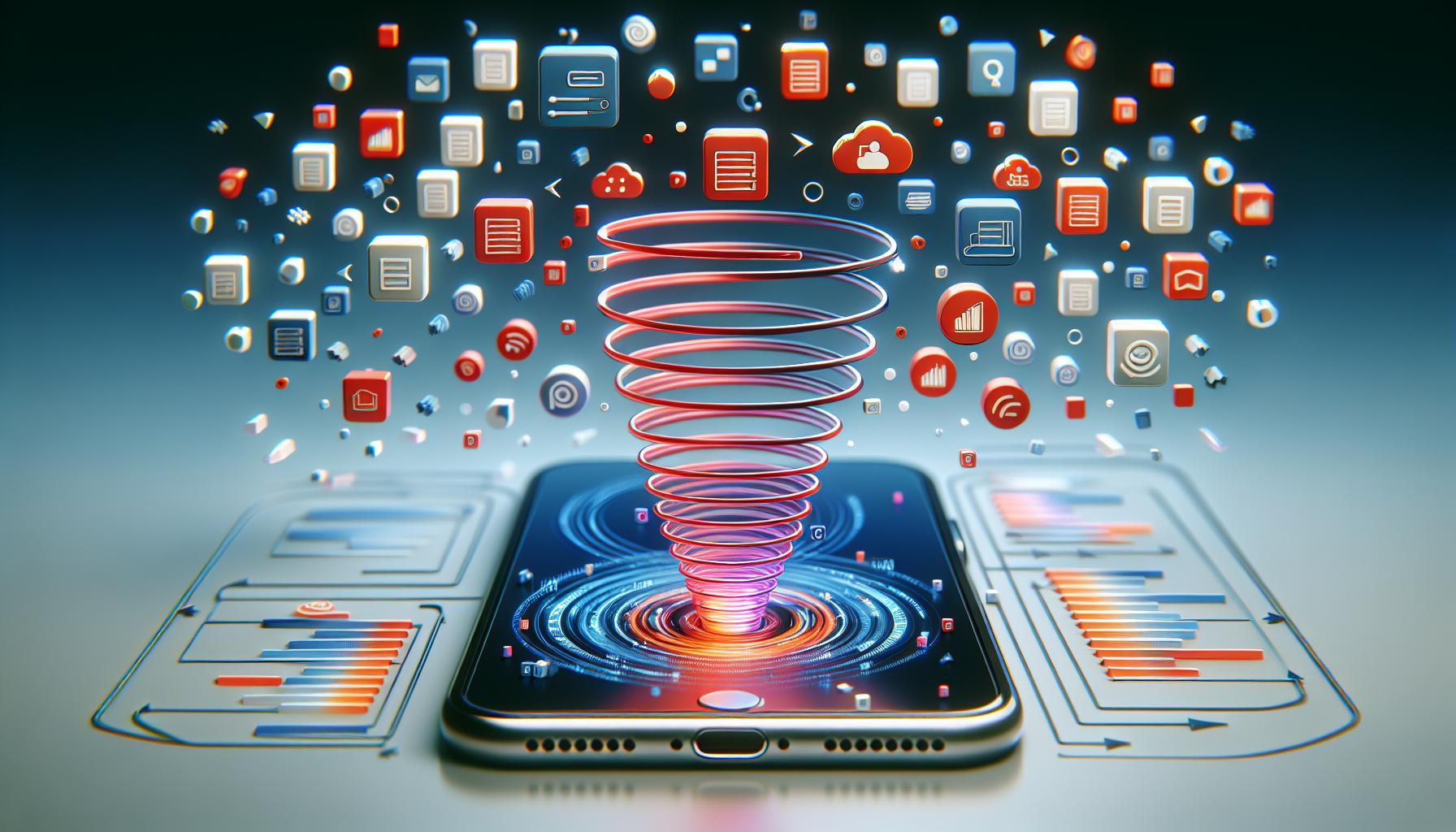Ever accidentally deleted a text message on your iPhone and thought it was gone for good? Think again. It's not as permanent as you might believe. In fact, there's a good chance that you can recover those seemingly lost messages with the right steps.
You might be wondering, "How's that possible?" Well, it's all about understanding the inner workings of your iPhone. Despite what you might think, when you delete a text, it's not instantly wiped from your device. Instead, it's simply marked for deletion and can be recovered until it's overwritten by new data.
Understanding the inner workings of your iPhone
Your iPhone is more intelligent than you might think. When you hit delete on a text message, your phone doesn't immediately wipe it out. Instead, it's marked for deletion and becomes inaccessible from your view. But here's the catch, it still resides on your device!
This approach is part of Apple's advanced operating system design. Until the system requires more space and decides to overwrite the "to be deleted" segment, your texts are safely snug in the memory vault. The more capacity your iPhone has, the longer these files stick around.
Interestingly, there's no hard rule set on when these texts will be removed permanently. It could take anywhere from weeks to never at all, depending on how often you use your phone, and the kind of tasks you put it to. If you're one who's regularly updating your apps, taking high-resolution pictures, or storing media, then chances are, your deleted text messages get overwritten sooner.
As a safety measure, iPhones come with a built-in system to back up your data regularly. When enabled, this backup system can also recover your deleted messages.
So don't panic the next time you accidentally erase an essential text message. As you now know, understanding the inner workings of an iPhone can be your silver bullet in getting back your lost messages. All it takes is knowing the right tricks and tools to use. Let's move on to discovering some of these handy recovery solutions.
The importance of acting quickly

Time is of the essence when it comes to recovering deleted messages on your iPhone. This isn't because the messages vanish into the ether once deleted. On the contrary, they're earmarked for deletion and remain lurking in the depths of your device's memory.
The real enemy here is new data. Every new message, photo, app download, or system update has the potential to overwrite and permanently erase the deleted text messages you're hoping to recover. Therefore, the more you use your iPhone after deleting a message, the smaller your window of opportunity becomes for successful recovery.
Your device doesn't select which data gets overwritten based on how integral it is to you personally. Rather, it casts a wide net, overwriting old, marked data in an indiscriminate fashion. This brings us back to our first point – the need to act quickly.
You might be wondering, "How quickly should I intervene?" Well, as with most things in life, it's not black and white. However, the sooner you cease using your iPhone and start the recovery process, the better your chances of success.
But remember, all hope isn't lost even if some time has passed. The built-in system on iPhones that backs up data regularly can be your last-minute savior. This system can be leveraged to recover text messages that might've been accidentally deleted and subsequently overwritten.
So, it's crucial to understand just how exactly this built-in backup system works. Grasping this will equip you to make the most of this handy iPhone feature, potentially saving you from some distressing data loss scenarios.
Backing up your data
Learning how to back up your data is a crucial step in the process of recovering permanently deleted text messages on your iPhone. So let's talk about how to do it right.
You can't underestimate the power of regular backups. While it may seem like an extra chore on your already busy schedule, performing regular backups can be a vital task. It's like insurance for your data. Not only do they save your messages, but also your photos, videos, contacts, and other important data.
Your iPhone comes with built-in tools for this task. Encouragingly, Apple's iCloud and iTunes offer reliable backup solutions for all your iPhone data. In fact, they're set up to back up your data automatically once you set it up, so you don't have to worry about forgetting.
How about we dive into each of these backup systems?
iCloud Backup
Here's how you set up iCloud backup:
- Go to your iPhone's "Settings" > tap on your name > "iCloud"
- Scroll down and select "iCloud Backup"
- Slide the "iCloud Backup" switch to the 'ON' position
Next, select the "Back Up Now" option, and your iPhone will start the backup process. It's a good idea to connect your iPhone to WiFi while backing up, as data transmission rates are higher and it doesn't eat into your cellular data limit.
IMPORTANT: For iCloud backups to occur automatically, your iPhone must be connected to WiFi, locked, and charging.
iTunes Backup
Performing an iTunes backup is another straightforward process. Here's how:
- Connect your iPhone to your computer using a USB cable
- Open iTunes and select the small iPhone icon in the top-left corner
- Under the "Backup" section, choose "This Computer" then "Back Up Now"
Remember, your backups are stored on your computer's hard drive when you use iTunes, unlike iCloud backups, which are stored in the cloud. So you want to ensure your computer has ample storage space.
By performing these simple tasks, you're ensuring your precious data remains secure even if they accidentally get deleted. This habit is your first line of defense against unexpected data loss.
Recovering deleted text messages using iCloud or iTunes
By now, you've realized the importance of backing up regularly, equipping yourself with that vital insurance for your data. Close on its heels is understanding how to recover those backed-up messages when the unexpected occurs. If you've acted quickly and you've got a recent backup, either through iCloud or iTunes, recovering deleted text messages won't be as daunting as you might think.
If iCloud is your backup solution of choice, here's how to go about it:
- Go to "Settings," tap on your name, and then "iCloud".
- Select "Manage Storage," followed by "Backups."
- You'll see a list of backups for different devices, select your iPhone and check the date on the most recent backup.
If the backup happened before you deleted those messages, it's a goldmine. To retrieve these messages, you'll need to reset your iPhone and restore it from the iCloud backup. That may sound a bit drastic but remember, it's necessary.
On the other hand, if you rely on iTunes for your backup needs, recovery is quite straightforward. Connect your iPhone to your computer and launch iTunes.
Start by:
- Clicking on the iPhone icon when it appears in iTunes.
- In the "Backups" section, click "Restore iPhone..."
- Choose the most recent backup that is dated before you deleted your messages.
Keep in mind that in both cases, restoring your phone effectively wipes your current data, replacing it with the information in the backup. This method is best suited if your lost messages are more valuable than your most recent, still intact, data.
By understanding these processes, you're taking steps to safeguard your messages. What lies ahead are more techniques for tackling data recovery - should your first line of defense fall short.
Using third-party software for text message recovery

Moving past iCloud and iTunes there's another viable option we'd like to introduce to you: third-party software for message recovery. Apps such as Dr.Fone, Enigma Recovery, and iMobie PhoneRescue promise to help you recover deleted messages. Due to their efficiency and ease of use, they've become popular tools in the realm of data recovery.
Dr.Fone, a product of Wonderspace, supports iOS data recovery. It’s designed to retrieve lost or deleted data like messages, photos, contacts, and notes. It's straightforward - you connect your device, scan for lost data and recover what you need.
Enigma Recovery, on the other hand, allows you to recover, restore, and export data from your device. It also offers the flexibility to export found data directly to your desktop.
iMobie PhoneRescue is another reputable software. It’s made for recovering more than 22 types of data. This app bends towards a more comprehensive recovery of lost files.
Here's a simplified guide on using these tools:
- Download and install the third-party data recovery app of your choice.
- Connect your iPhone to the computer, and allow the software to detect your device.
- Select 'Recover from iOS device', then choose 'Start Scan'.
- Preview and select the text messages you want to recover.
- Finally, click 'Recover' to regain your text messages.
Remember, apps vary in terms of the precise steps to take. Make sure to check the guidelines specific to your chosen software.
Note: Always be careful when granting third-party tools access to your personal data. Ensure the software you use has a proven track of good user reviews and prioritizes safety.
Additionally, be aware that you'll seldom get a 100% success rate. Some messages might not be retrieved. This shortfall is primarily because these apps can only recover data that hasn't been overwritten by new information. For best results, start the recovery process as soon as possible after the data loss.
While data recovery seems complex, the user-friendly design of these devises makes it manageable, even for tech novices. It’s a sign that technology, in its many forms, continues to offer solutions even when we think all hope's lost. So, keep exploring, you never know what else is out there to make your digital life easier.
Conclusion
You've now got the know-how to tackle the issue of recovering deleted text messages on your iPhone. Regular backups are your best friend, but if you've missed that step, iCloud, iTunes, or third-party software like Dr.Fone, Enigma Recovery, and iMobie PhoneRescue can come to your rescue. Remember, these tools are designed to be user-friendly and technology continues to advance to make your digital life easier. However, don't forget to be mindful when granting them access to your personal data. While the recovery success rate may not be perfect, starting the process as soon as possible after data loss can increase your chances. So here's to no more lost messages and a more secure digital experience!
Frequently Asked Questions
1. Why is it important to backup data regularly?
Regular data backups minimize the risk of losing valuable information. Should an unexpected event occur, like accidental deletion or device damage, users can easily retrieve their data from the backup.
2. How can I recover deleted text messages?
You can recover deleted messages using iCloud, iTunes, or third-party recovery tools like Dr.Fone, Enigma Recovery, or iMobie PhoneRescue. The article provides a step-by-step guide for each method.
3. Is it safe to use third-party software for data recovery?
While third-party tools can be highly effective for data recovery, it is crucial to be careful when granting these programs access to personal data. Use verified and reliable recovery software.
4. Can all lost data be recovered successfully?
The success rate of data recovery may not always be 100%. Some factors such as the time elapsed since the data loss could affect recovery success.
5. How user-friendly are these recovery tools?
These recovery tools are designed to be user-friendly, factoring in simplicity, and ease of navigation. Continuous technological advancements contribute to the user-friendliness of these tools.




